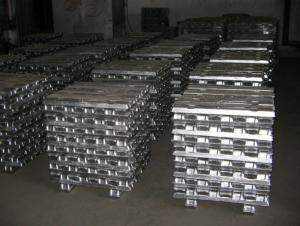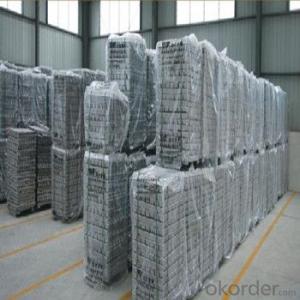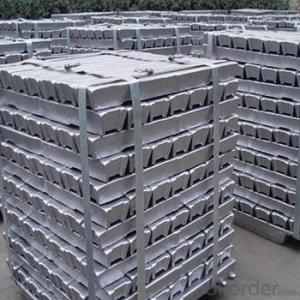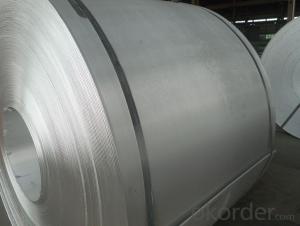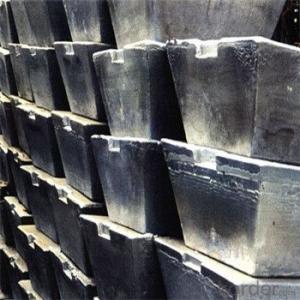Aluminium Ingots with High 99.99% Purity and Competitive Price
- Loading Port:
- China main port
- Payment Terms:
- TT OR LC
- Min Order Qty:
- 1000 m.t.
- Supply Capability:
- 10000 m.t./month
OKorder Service Pledge
OKorder Financial Service
You Might Also Like
Pure Aluminum Ingot Used for Industry
1.Structure of Aluminum Ingot Description
Aluminum Ingot is with the AL as the main chemical composition. Aluminum Ingot is used for industry,such as automobile,pinning and weaving,electron broadly and so on. Aluminum Ingot has the following advantages: easy control and operation, fast melting.
2.Main Features of the Aluminum Ingot
•High Purity
•Easy control and operation
•High strength
•Fast melting
•Competitive price
•Best Service
3. Aluminum Ingot Images

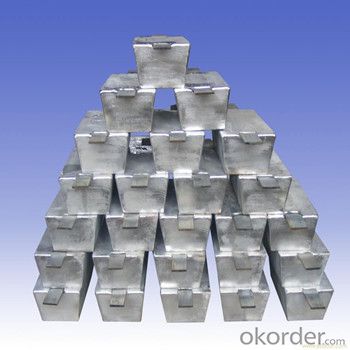
4. Aluminum Ingot Specification
Grade | Chemical Composition % | |||||||||
Al≥ | impurities ≤ | |||||||||
Si | Fe | Cu | Ga | Mg | Zn | Mn | others | Sum | ||
Al99.9 | 99.90 | 0.50 | 0.07 | 0.005 | 0.02 | 0.01 | 0.025 | - | 0.010 | 0.10 |
Al99.85 | 99.85 | 0.80 | 0.12 | 0.005 | 0.03 | 0.02 | 0.030 | - | 0.015 | 0.15 |
Al99.7 | 99.70 | 0.10 | 0.20 | 0.010 | 0.03 | 0.02 | 0.030 | - | 0.030 | 0.30 |
Al99.6 | 99.60 | 0.16 | 0.25 | 0.010 | 0.03 | 0.03 | 0.030 | - | 0.030 | 0.40 |
Al99.5 | 99.50 | 0.22 | 0.30 | 0.020 | 0.03 | 0.05 | 0.050 | - | 0.030 | 0.50 |
Al99.00 | 99.00 | 0.42 | 0.50 | 0.020 | 0.03 | 0.05 | 0.050 | - | 0.050 | 1.00 |
5.FAQ of Aluminum Ingot
We have organized several common questions for our clients,may help you sincerely:
①How about your company?
A world class manufacturer & supplier of castings forging in carbon steel and alloy steel,is one of the large-scale professional investment casting production bases in China,consisting of both casting foundry forging and machining factory. Annually more than 8000 tons Precision casting and forging parts are exported to markets in Europe,America and Japan. OEM casting and forging service available according to customer’s requirements.
②How to guarantee the quality of the products?
We have established the international advanced quality management system,every link from raw material to final product we have strict quality test;We resolutely put an end to unqualified products flowing into the market. At the same time, we will provide necessary follow-up service assurance.
③How long can we receive the product after purchase?
In the purchase of product within three working days, We will arrange the factory delivery as soon as possible. The pecific time of receiving is related to the state and position of customers.Commonly 7 to 10 working days can be served.
- Q:How are aluminum ingots used in the production of heat exchangers?
- Due to their excellent thermal conductivity, lightweight properties, and corrosion resistance, aluminum ingots find extensive use in the manufacturing of heat exchangers. These devices are responsible for transferring heat between multiple fluids, and aluminum ingots play a vital role in enhancing their efficiency and durability. Firstly, the thermal conductivity of aluminum surpasses that of many other metals, making it an ideal material for heat exchangers. Its high thermal conductivity enables efficient heat transfer between fluids, resulting in rapid and effective temperature exchange. This quality proves especially advantageous in applications that require swift heat transfer, such as automotive radiators or air conditioning systems. Additionally, aluminum ingots offer a lightweight alternative to metals like copper or steel. This characteristic is particularly beneficial in industries where weight reduction is crucial, like aviation and automotive. The lightweight nature of aluminum ingots not only helps reduce the overall weight of the system but also facilitates easy handling and installation of heat exchangers. Moreover, aluminum ingots possess exceptional corrosion resistance, especially when exposed to harsh environments or corrosive fluids. This resistance is attributed to the formation of a thin protective oxide layer on the surface of the aluminum, preventing further oxidation and degradation. Heat exchangers often come in contact with various fluids, some of which may be corrosive. By utilizing aluminum ingots, the risk of corrosion-related failures is minimized, ensuring the long-lasting and reliable performance of the heat exchanger. Furthermore, aluminum ingots offer versatility in terms of fabrication and customization. They can be easily cast, extruded, or formed into complex shapes, allowing for the production of heat exchangers with intricate designs and optimized performance. This flexibility in manufacturing processes enables the production of heat exchangers tailored to specific requirements, further enhancing their overall efficiency and effectiveness. In conclusion, aluminum ingots are crucial components in the manufacturing of heat exchangers due to their superior thermal conductivity, lightweight properties, corrosion resistance, and versatility in fabrication. Their utilization significantly improves heat transfer efficiency, reduces weight, ensures durability, and allows for customization, making them the preferred choice in various industries.
- Q:Want to do a scrap processing of aluminum ingots of small workshops, about investment of about 100 thousand, the specific process, need what equipment technology, please expert advice
- I suggest actually visiting the small workshop. I was in this industry before. Another important point, the water rate, is able to turn out 100 kilograms of scrap aluminum water how many kilograms, finally cooled into aluminum ingots, which is the key of this industry
- Q:What are the different forms of aluminum ingots available in the market?
- There are several different forms of aluminum ingots available in the market, including standard ingots, T-ingots, sow ingots, and rolled ingots.
- Q:What are the health risks associated with working with aluminum ingots?
- Certain health risks can be associated with working with aluminum ingots due to the potential exposure to various hazards. The following are some health risks that are commonly associated with working with aluminum ingots: 1. Inhaling aluminum particles: There is a risk of inhaling fine aluminum particles during the handling and processing of aluminum ingots. Prolonged exposure to aluminum dust or fumes can lead to respiratory problems such as bronchitis, pulmonary fibrosis, or even lung cancer. 2. Irritation of the skin and eyes: Direct contact with aluminum ingots or its dust can cause skin irritation, redness, and rashes. It may also cause eye irritation, resulting in redness, itching, or a burning sensation. 3. Potential neurological effects: Chronic exposure to aluminum, especially through inhalation or ingestion, has been linked to possible neurological effects. Although the exact mechanisms are not fully understood, there is some evidence suggesting a connection between aluminum exposure and the development or progression of neurodegenerative diseases, such as Alzheimer's disease. 4. Occupational asthma: Exposure to aluminum dust or fumes can trigger or worsen asthma symptoms in individuals who are already prone to respiratory conditions. This can lead to difficulties in breathing, wheezing, coughing, and chest tightness. 5. Heavy metal toxicity: Aluminum is classified as a heavy metal, and excessive exposure can result in heavy metal toxicity. Symptoms of aluminum toxicity may include gastrointestinal issues, bone pain, muscle weakness, and potential damage to the nervous system. To minimize these health risks, it is crucial to implement appropriate safety measures and adhere to proper protocols when working with aluminum ingots. This includes wearing personal protective equipment (PPE) such as gloves, goggles, and respiratory masks, ensuring adequate ventilation in the workplace, and regularly cleaning to reduce the accumulation of aluminum dust. Additionally, individuals working with aluminum ingots are advised to undergo regular medical check-ups and monitoring to detect any potential health issues at an early stage.
- Q:Can aluminum ingots be used in 3D printing?
- Yes, aluminum ingots can be used in 3D printing. Aluminum is a commonly used material in additive manufacturing processes such as selective laser melting (SLM) or direct metal laser sintering (DMLS). By melting the aluminum ingots and layering it in a precise manner, it is possible to create complex and durable 3D printed metal parts.
- Q:What are the challenges in recycling scrap aluminum ingots?
- One of the challenges in recycling scrap aluminum ingots is the presence of impurities and contaminants. These impurities can affect the quality of the recycled aluminum and may require additional processing steps to remove them effectively. Additionally, the collection and sorting of scrap aluminum can be challenging due to its widespread use in various industries, leading to difficulties in sourcing sufficient quantities of clean and uncontaminated scrap material. Finally, the energy-intensive nature of aluminum production and recycling poses a challenge in terms of the environmental impact and cost-effectiveness of the recycling process.
- Q:What is the difference between remelting aluminium ingot and alloy aluminium ingot?
- The general is scrap aluminum remelting aluminum ingot, all kinds of discarded products by melting furnace melting, remelting aluminum components, is likely to exceed the standard, some elements of impurities, authentic alloy ingot is made of pure aluminum made with various metal elements according to the ratio of melting, various elements with fewer impurities than accurate, high quality products. Out of the production.
- Q:What are the common defects found in aluminum ingots?
- There are several common defects that can be found in aluminum ingots. One of the most common defects is porosity, which refers to the presence of small voids or air pockets within the ingot. Porosity can occur due to improper casting techniques or insufficient degassing of the molten aluminum. This defect can weaken the overall structure of the ingot and reduce its mechanical properties. Another common defect is segregation, which occurs when there is an uneven distribution of alloying elements or impurities within the ingot. This can result in variations in the composition and properties of different sections of the ingot. Segregation can be caused by improper alloying or inadequate mixing of the molten aluminum. Cracking is another defect often found in aluminum ingots. This can occur during cooling or solidification of the ingot if there is rapid or uneven cooling, leading to thermal stress and cracking. Cracking can also be caused by excessive hydrogen content in the aluminum, which can promote the formation of internal cracks. In addition, surface defects such as dross, oxide films, and inclusions can be commonly found in aluminum ingots. Dross refers to the impurities and oxides that float on the surface of the molten aluminum, which can become trapped in the ingot during solidification. Oxide films can form on the surface of the ingot due to exposure to air or inadequate protection during casting. Inclusions, on the other hand, are foreign particles or non-metallic compounds that are trapped within the ingot during solidification. These defects can have a significant impact on the quality and performance of aluminum ingots. Therefore, it is crucial to employ proper casting techniques, control alloy composition, ensure adequate degassing, and implement effective quality control measures to minimize the occurrence of these defects.
- Q:What is the casting process for aluminum ingots?
- The casting process for aluminum ingots involves several steps to ensure the production of high-quality, uniform ingots. First, the raw aluminum is melted in a furnace at temperatures exceeding 660 degrees Celsius (1220 degrees Fahrenheit). The molten aluminum is then transferred to a holding furnace, where it is maintained at a consistent temperature to prevent solidification. Next, a mold is prepared for casting the aluminum ingots. The mold is typically made of steel or cast iron and is preheated to minimize thermal shock. The mold is also coated with a release agent to prevent the ingot from sticking to the mold. Once the mold is ready, the molten aluminum is poured into it. The pouring process can be done manually or using automated equipment, depending on the scale of production. The molten aluminum fills the mold, taking the shape of the desired ingot. After pouring, the mold is allowed to cool and solidify the aluminum. Cooling time varies depending on the size and thickness of the ingot. As the aluminum cools, it undergoes a phase transformation from liquid to solid, forming a solid ingot. Once the ingot is solidified, it is removed from the mold. This can be achieved by either manually removing the ingot or using mechanical means, such as vibrators or hydraulic presses, to eject the ingot from the mold. Finally, the ingots are typically subjected to further processing, such as heat treatment or surface finishing, to enhance their mechanical properties and appearance. These additional steps may include homogenizing the ingots to ensure uniformity, removing surface defects, or applying protective coatings. Overall, the casting process for aluminum ingots is a complex and precise operation that requires careful control of temperature, mold preparation, and post-processing steps to produce high-quality ingots suitable for further aluminum processing and applications.
- Q:What does aluminium ingot blacken because of temperature? Rain? Aluminium oxide? Iron salt?
- The humidity is contacted with the air and is oxidized. The aluminum ingot also contains trace amounts of other metal elements, which are also oxidized to black
1. Manufacturer Overview |
|
|---|---|
| Location | |
| Year Established | |
| Annual Output Value | |
| Main Markets | |
| Company Certifications | |
2. Manufacturer Certificates |
|
|---|---|
| a) Certification Name | |
| Range | |
| Reference | |
| Validity Period | |
3. Manufacturer Capability |
|
|---|---|
| a)Trade Capacity | |
| Nearest Port | |
| Export Percentage | |
| No.of Employees in Trade Department | |
| Language Spoken: | |
| b)Factory Information | |
| Factory Size: | |
| No. of Production Lines | |
| Contract Manufacturing | |
| Product Price Range | |
Send your message to us
Aluminium Ingots with High 99.99% Purity and Competitive Price
- Loading Port:
- China main port
- Payment Terms:
- TT OR LC
- Min Order Qty:
- 1000 m.t.
- Supply Capability:
- 10000 m.t./month
OKorder Service Pledge
OKorder Financial Service
Similar products
New products
Hot products
Hot Searches
Related keywords







